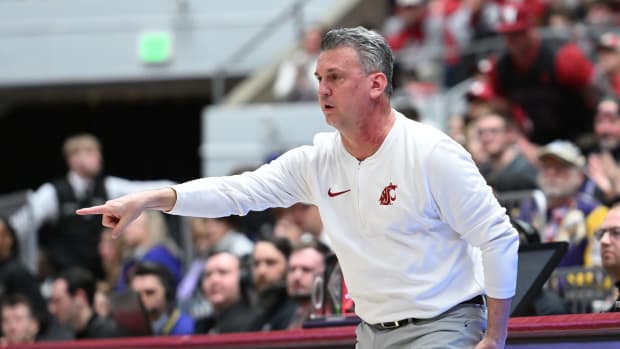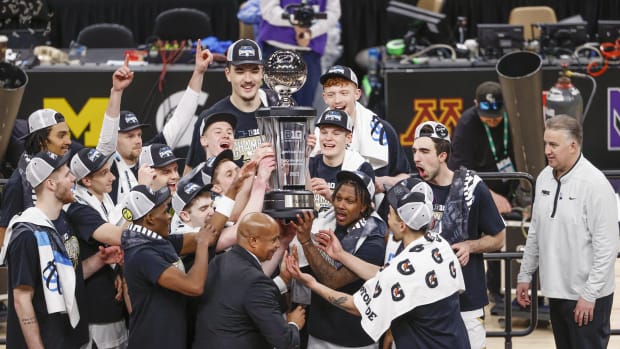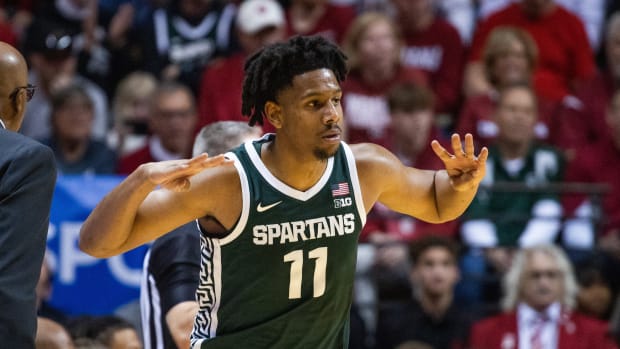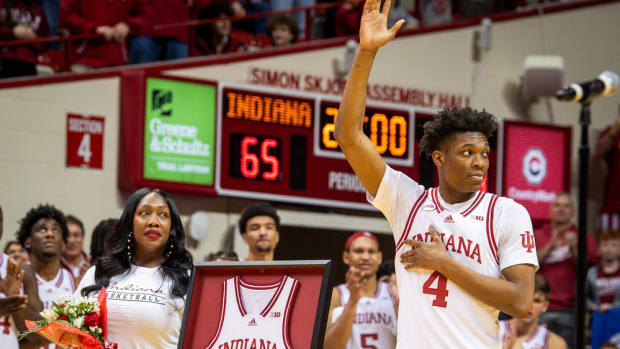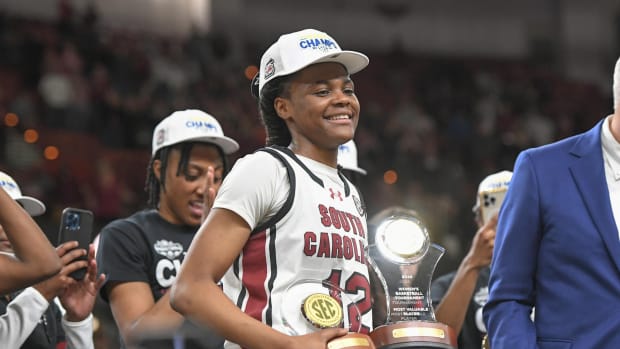Forde Minutes: Blooming Big Men, Hot Seats and the Shift Westward
Forty names, games, teams and minutiae making news in college basketball (golden goose burial plot sold separately at Louisville):
LOW POST MAULER BALL IS NOT DEAD
Chet Holmgren may be the 7-footer of the future, in terms of skill set and all-court ability. But the present still has room for a large number of really good teams that are led by big men who play big, hunkering down near the basket and doing their work in the paint far more than the perimeter.
In a world full of jump shooters, Mauler Ball lives in 2022. And lives large. The Minutes salutes nine guys who are leading their teams from the inside in an era of perimeter players.
Oscar Tshiebwe (1), Kentucky. We never got to see Moses Malone play college basketball (Google him, kids), but if he did it probably would look a lot like Tshiebwe does in a Wildcats uniform. He’s a rebounding savant, a quick jumper with long arms and great hands. John Calipari has always prized aggressive big men who bully opponents on the glass, and the 6'9", 255-pound West Virginia transfer was the perfect addition.
He leads Kentucky in scoring (16.3 points) and leads the nation in rebounding (15.1). His 5.1 offensive boards per game are more than a rebound ahead of the second-best player in men’s Division I. If it sometimes appears that he’s just throwing the ball at the rim so he can retrieve it again, well, good luck keeping him from getting it. People used to say the same thing about Malone.
Commitment to the paint: Per Synergy Sports, 77.7% of Tshiebwe’s shots are around the basket and/or in post-up situations. He has attempted zero three-point shots in 62 college games.
Kofi Cockburn (2), Illinois. In the aftermath of Ayo Dosunmu’s run as the marquee Illini player, Cockburn has increased his production and expanded his already imposing presence. He’s the only player taller than 6'7" scoring more than 20 points per game, and one of just two players nationally averaging more than 20 points and 10 rebounds. The biggest reason Illinois is tied for first in the Big Ten is its biggest human, at 7'0", 285 pounds.
Cockburn relishes the contact inside, ranking fifth nationally in fouls drawn per 40 minutes at 7.5. His 7.3 free throw attempts per game is in the top five nationally as well. But his biggest statistical improvement is on the defensive glass, where he is sixth nationally at 8.1 rebounds per game.
Commitment to the paint: A whopping 96% of his shots are around the basket/post-ups, per Synergy. The junior’s one and only three-point attempt as a collegian came in the 10th game of his freshman year.
Zach Edey (3), Purdue. He’s the biggest man yet at Big Man U, checking in at 7'4", 295 pounds, with a 77-inch wingspan and size-20 feet. Edey was an intriguing freshman for Matt Painter last year, then had an impactful summer playing internationally for Canada and now is basically performing a low-post job share with Trevion Williams (see below).
Edey has had seven 20-point games this season despite playing more than 21 minutes only twice, and never playing more than 27. He makes his shots count, leading the nation in field-goal percentage at 70.4, and has yet to have a game this season where he made fewer than half his shots. He’s the only player in the Big Ten drawing more fouls per 40 minutes (7.8) than Cockburn.
Commitment to the paint: There is only one place for a player of his dimensions, and Edey gets that. He’s taken 98.5% of his shots near the basket or off post-ups. Synergy says he has attempted one jump shot this season, and he has yet to take a three in college.
Trevion Williams (4), Purdue. The other half of the Boilermakers’ bruise brothers inside is smaller than Edey (6'10", 255 pounds) but just as committed to the grind. Williams has been willing to come off the bench most of his senior season while playing about half his team’s minutes, making more room for Edey. But when Williams is in the game, the offense flows through him even more than through standout guard Jaden Ivey, in part because of the center’s improved passing.
Williams is Purdue’s leader on the defensive glass and leads the Big Ten in defensive rebounding rate, including a career-high 17 defensive boards against Iowa. His decision to come back for his senior season has buttressed the Boilers’ hopes for making their first Final Four since 1980.
Commitment to the paint: Williams has a bit more freedom than others on this list to stray to the perimeter, having attempted eight three-pointers and made three. But he hasn’t shot a three in two weeks, and hasn’t made one in nearly a month. Synergy says 86.9% of his shots are around the basket or off post-up situations.
Mark Williams (5), Duke. No coach in college basketball history has championed the free-floating big man more than Mike Krzyzewski, but that freedom to roam doesn’t extend to Williams. The 7-foot sophomore is purely an inside player at this point in his career.
Williams’s progress from his freshman season has showed in every area. His numbers are up across the board, most notably rebounding (up from 4.5 to 7.1) and blocked shots (up from 1.4 to 3.2, which ranks 11th nationally). He’s scored in double figures in five straight games and had double doubles in three of those, while averaging more than 27 minutes per game.
Commitment to the paint: Williams has taken 95.4% of his shots from short range or off post ups. He did shoot the only three of his college career in a win over Gonzaga, sullying an 8-for-8 shooting performance from two-point range.
Adama Sanogo (6), Connecticut. Buy stock now in this flourishing sophomore from Mali. He’s having a breakout season despite missing four games with an abdominal injury. “He thinks he’s better than everybody, and you cannot convince him otherwise,” UConn coach Danny Hurley said after Sanogo hung 26 points, 18 rebounds and six blocks on St. John’s earlier in January. “But he works like he’s a nobody on his game. He’s humble that way but arrogant when the ball goes up.”
In January alone, Sanogo averaged 17.1 points, 12.3 rebounds and 3.1 blocked shots. Not coincidentally, the Huskies are on a five-game winning streak, although the competition is about to improve appreciably.
Commitment to the paint: Synergy says that 87.6% of the 6'9" Sanogo’s shots have come from close range. He attempted (and missed) one three as part of UConn’s wild, 115–109, double-overtime win over Auburn in November—a game in which Sanogo scored 30 points and had eight turnovers.
Matthias Tass (7), Saint Mary’s. Randy Bennett loves his international bigs, and the Estonian senior Tass is the latest in that line to star for the Gaels. He’s become a much bigger part of the offensive game plan this season, helping Saint Mary’s to a 17–4 record.
Tass has scored in double figures 14 straight games and has upped his shooting percentages from 53% to 59% from two-point range and from 62% to 75% at the foul line year-over-year.
Commitment to the paint: The 6'10", 245-pounder has taken 84.6% of his shots from close range. He does have some latitude to shoot threes, having attempted 12 of them this season, but six of those came in a splurge against UC Riverside on Nov. 29. Since then he is 0 for 5.
Trayce Jackson-Davis (8), Indiana. Is he Pervis Ellison with a bit less range? Whatever the comp, Jackson-Davis is lively and aggressive and making his decision to return for his junior season look very smart.
Jackson-Davis leads the Hoosiers (16–5) in scoring (18.3 points), rebounds (8.5), blocks (2.7) and field-goal percentage (60.1), standing as the biggest reason Indiana is poised to make the program’s first NCAA tournament since 2016. He’s playing a bit less than last year but more efficiently, with his shooting percentage up nearly nine points from 2021.
Commitment to the paint: Jackson-Davis has taken 883 career shots from the field, and just two are threes. Neither went in. Synergy says 93.9% of his shots are from close range.
Johni Broome (9), Morehead State. In the transfer era, the Eagles scored immensely by keeping Broome for a second collegiate season. Following a precocious freshman year that ended in an NCAA tournament bid, he’s been even better this time around.
The 6'10" Floridian is third nationally in double doubles with 15 and third in blocks at 3.7 per game. He’s increased his production across the board despite only a modest bump in playing time (from 25.8 minutes to 27.8). In his last four games he’s averaged 5.8 blocks.
Commitment to the paint: 92% of his shot attempts are from close range. Broome has attempted three threes, but none since before Christmas.

Purdue's Edey; Syracuse coach Jim Boeheim and UConn's Sonogo.
Rob Kinnan; Marc Lebryk; David Butler II/USA TODAY Sports
FIRING SEASON STARTED EARLY; WHO COULD BE NEXT?
Now that Chris Mack (10) has been whacked at Louisville, joining former Maryland boss Mark Turgeon on the sidelines, who else is feeling heat? A quick Minutes assessment:
Jim Boeheim (11), Syracuse. Simply put, this is the worst of his 46 teams at the school. The Orange are 10–11 and in serious jeopardy of recording their first losing season since the 1960s, playing atrocious defense. There is too much Boeheim going on—not just Jim coaching at age 77, but both his sons (Jimmy and Buddy) leading the team in minutes played and shots attempted. Boeheim has established himself as ruler of his own fiefdom, impervious to prior attempts to get him to retire, but it might be time for the family to move on after this season.
Penny Hardaway (12), Memphis. Hardaway built his fourth Memphis team around a monster freshman class, then complained about excessive media criticism as the Tigers staggered to a 9–8 start with losses to Georgia, Mississippi, Tulane and East Carolina. Memphis got the ship steadied last week, winning two games while shorthanded, and Hardaway apologized for the outburst that followed a loss to SMU on Jan. 20. But on the whole this has been a chemistry disaster, with just-turned-18-year-old Emoni Bates in over his head and plenty of other deficiencies.
Patrick Ewing (13), Georgetown. His overall record in five seasons at his alma mater has now dipped below .500. The Hoyas are last in the Big East at 0–7 and haven’t won a game since Dec. 15. Their best win is over the previously mentioned dumpster fire that is Syracuse. Last year’s Big East tournament title run was a four-game fluke, with no carryover into March Madness and certainly none this season. Ewing is a Georgetown treasure, but at what point does the school have to disengage from nostalgia and make a change?
Bruce Weber (14), Kansas State. This has traditionally been a loyal place to its coaches, and Weber has had some fine moments at the school. But this is Year 10 and he’s now careening toward a third straight losing season. Weber’s record is 30–51 since the 2019 team flamed out in the NCAA first round as a No. 4 seed. With just one season left on his contract after this one, the buyout should be in the manageable range.
Fred Hoiberg (15), Nebraska. What looked like a solid hire of Hoiberg coming back to college from the NBA has been a three-season disaster. His record: 20–60, 5–44 in the Big Ten. The current team has a lot of close losses, but they’re still losses. The Cornhuskers have won one game since November, and that was over Kennesaw State. Best win of the year: over Sam Houston State on Nov. 12. Hoiberg doesn’t have the former-star-player-loyalty card to play that has helped keep football counterpart Scott Frost employed.
Chris Collins (16), Northwestern. That blissful blip of an NCAA tournament season in 2016–17 continues to recede in the rearview mirror. Since then: nothing but losing seasons. The current Wildcats are consistently competitive in the Big Ten, but also consistently losing—they’re 2–8 in league play, though the schedule offers some hope this week with Rutgers at home and Nebraska on the road. Ultimately, Northwestern has to decide what the expiration date should be on cachet earned from the only NCAA bid in program history.
Others to watch: Tom Crean, Georgia; Bobby Hurley, Arizona State; Jeff Capel, Pittsburgh.
SHIFTING GEOGRAPHY
For much of the past 25 years, men’s college basketball’s power base has tilted East. Teams from the right side of the Mississippi River won titles and tended to be shipped out West for the NCAA tournament to balance out the bracket, since there was a paucity of powerhouses on that side of the country.
Gonzaga (17) went a long way toward balancing that out at the top in recent years. But this season, there might actually be too many top teams in the West and not enough on the other side of the country. The Big Dance seeding may require some teams to ship West to East to balance regions.
Currently, the West Coast has three legit No. 1 seed contenders: the Zags, UCLA (18) and resurgent Arizona (19). All are in the top nine of the KenPom rankings and top 10 of the NCAA NET.
Meanwhile, the ACC and Big East have Duke (20) and Villanova (21) and not much else in contention for a No. 1 seed. A year after finishing with nobody higher than 15th in the Pomeroy rankings, the lordly ACC currently has nobody higher than 12th (that’s the Blue Devils) and nobody else in the top 30. The Big East has a bit more depth, but UConn might be the only other member with a shot at a No. 1 or 2 seed.
Beyond its Big Three, the West also has several candidates for top-four seeds: USC (22), the best team from the Mountain West (23), and perhaps the second-best team from the West Coast Conference (24).
The Mountain West is having one of its best seasons in years, currently ranking No. 7 in Pomeroy’s conference pecking order. There are three teams in the top 40 of the NET Rankings (Boise State, Wyoming and Colorado State), plus two more in the top 51 (Utah State and San Diego State). Wyoming is the revelation of that group and has a huge week ahead, with Colorado State and Boise State both coming to Laramie.
The West Coast Conference also has some depth behind Gonzaga. Saint Mary’s has no bad losses and a pair of neutral-court victories that could resonate, over Notre Dame and Oregon. BYU suffered a shocking loss at abysmal Pacific on Saturday night, but still has a strong résumé. San Francisco and Santa Clara both have their best teams in years and could be in the at-large conversation.
Ultimately, teams out West could end up with the top two seeds in that region and be ticketed for the San Francisco regional (if they win their first two games) while a third could be sent East and potentially play in Philadelphia.

Lucas Williamson (left) and Loyola Chicago have hardly missed a beat under new coach Drew Valentine (right).
Christopher Hanewinckel/USA TODAY Sports
MID-MAJORS IN CONTENTION FOR AT-LARGE BIDS
Murray State (25). Record: 20–2, 10–0 in the Ohio Valley Conference. Conference rank: 24th out of 32, per Ken Pomeroy. Quality wins: Memphis and Belmont on the road; Chattanooga at home. Losses: East Tennessee State in Naples, Fla.; Auburn on the road. NCAA NET ranking: 27th. KenPom ranking: 37th. The Racers need to root for Memphis to get it together and improve the shine on that victory. The OVC has too many bad teams that drag down schedule strength, but this is a dominant team on a 10-game winning streak by an average margin of 19.1 points.
(Belmont could also be in the at-large mix from the OVC if the Bruins don’t win the automatic bid.)
Loyola Chicago (26). Record: 16–4, 7–2 in the Missouri Valley. Conference rank: 11th out of 32. Quality wins: San Francisco on a neutral floor; Vanderbilt and DePaul on the road. Losses: Michigan State and Auburn on neutral floors; Drake on the road; Missouri State at home. NCAA NET ranking: 31st. KenPom ranking: 32nd. The transition from Porter Moser to top assistant Drew Valentine has gone splendidly, with a veteran team still doing most of the things well that it had in the previous four seasons. Résumé is hurt by the demise of Arizona State, which the Ramblers beat in November.
UAB (27). Record: 17–5, 7–2 in Conference USA. Conference rank: 12th out of 32. Quality wins: North Texas, Louisiana Tech and Saint Louis on the road. Losses: South Carolina, Rice and Marshall on the road; San Francisco at a neutral site; West Virginia at home. NCAA net ranking: 45th. KenPom ranking: 47th. The Blazers are working on a ninth straight winning season but haven’t been to the NCAAs since 2015. The five losses are by a combined 19 points.
Davidson (28). Record: 17–3. 7–1 in the Atlantic-10. Conference rank: 10th out of 32. Quality wins: Alabama, VCU and Richmond on the road. Losses: San Francisco on the road; New Mexico State on a neutral court; VCU at home. NCAA NET ranking: 48th. KenPom ranking: 51st. A 9–2 record away from home, including that signature win over the Crimson Tide, could go a long way in the selection committee room. Big game Tuesday at St. Bonaventure.
VCU (29). Record: 13–6, 6–2 in the Atlantic-10. Conference rank: 10th out of 32. Quality wins: Davidson, Dayton and Vanderbilt on the road; Syracuse on a neutral court. Losses: Wagner, Chattanooga and Davidson at home; St. Bonaventure on the road; Baylor and UConn at neutral site. NCAA NET ranking: 56th. KenPom ranking: 65th. The Rams have played a ridiculous schedule, which has to count for something. They’d be helped if Syracuse and Vanderbilt finish well, but the tournament also kind of owes them one after being dismissed from the 2021 Big Dance before even playing a game for COVID-19 reasons.
(There is a third A-10 team to keep an eye on in St. Bonaventure, which began the season with a lot of hype and scored three big early wins, over Marquette, Boise State and Clemson. But the Bonnies had a long COVID-19 pause and have been uneven since mid-December. If they round back into peak form they could be the best team in the A-10.)
Chattanooga (30). Record: 18–4, 8–1 in the Southern Conference. Conference rank: 13th out of 32. Quality wins: VCU on the road, Furman at home. Losses: Charleston at home; Belmont, Murray State and Western Carolina on the road. NCAA NET ranking: 39th. KenPom ranking: 59th. The Mocs don’t have a lot of quality games left, but they should keep piling up victories. There is a wide discrepancy between how the NET and Pomeroy view Lamont Paris’s team.
Iona (31). Record: 18–3, 10–0 in the Metro Atlantic. Conference rank: 20th out of 32. Quality wins: Alabama on a neutral floor; Monmouth on the road. Losses: Belmont and Kansas on neutral floor; at Saint Louis. NCAA NET ranking: 57th. KenPom ranking: 70th. Chances are the Gaels will storm through the MAAC tournament and not need an at-large bid, but if they stumble they still have some things in their favor: the Alabama win, no bad losses and Rick Pitino as a TV draw.
FIVE QUESTIONS WITH A COACH
The Minutes sat down with Arizona rookie boss Tommy Lloyd in Los Angeles last week, before the Wildcats lost to UCLA. The former Gonzaga assistant discussed how he’s hit the ground running, charging out to a 17–2 record and re-establishing the Arizona brand near the forefront of the sport.
Minutes Q: What’s been the most pleasant development in this start?
Lloyd: I ended up in a great place. Once I got doing it, I probably was more ready than I knew (32). So I’ll give a ton of credit for Fewie [Mark Few] and Gonzaga for that. And I’m getting together with a great group of guys. They have a great spirit. It’s a group that is uniquely put together [eight foreign players on the roster], and they’ve been fun. For them to listen to me and trust me, it’s been cool.
Q: You have experience recruiting and coaching foreign players at Gonzaga. Has there been carryover from that to Arizona?
Lloyd: I’m sure there has been. Maybe I’m just so used to dealing with different personalities and cultures that maybe it’s just second nature (33). There’s a connection point for me with a lot of those guys that’s probably unique.
Q: How hungry is the fan base for this success?
Lloyd: Honestly, I haven’t put too much thought into it. But they’re an educated fan base. I didn’t want to come in and be like, ‘There’s a new sheriff in town, we’re doing things this way, I’ve got all the answers (34).’ I just wanted to coach. Hopefully proof of concept will be respected and they’ll appreciate that. I don’t want to oversell and under-deliver.
Q: In what ways did you surprise yourself in terms of your readiness for this job?
Lloyd: I’ve always loved coaching and teaching and taken that seriously. I worked at my craft and Fewie let me work at my craft. He listened to some of my crazy ideas—he said no to some, but he tried some, too. I got to try things, so I’m able to coach on things that I have a conviction about. I was with him and beside him, but I was teaching, too. But I also have a reminder for myself: effort before execution. Because I can get tied up in the details. I don’t want to limit my team because I’m trying to impress myself as a coach (35). Sometimes you get stuck in the minutiae because you’re trying to coach against the theory of the game. I love the attack/counter attack stuff, the give and take, but I also want the guys to just play.
Q: I’m sure you’ve noticed that Arizona and Gonzaga are near the top of most metrics. How do you feel seeing that?
“It’s great, it’s fun. Obviously I’m proud of Gonzaga and everything they’ve done. It reassures me that we were doing the right things and I’m doing the right things. When we finally got to the 2017 Final Four championship game, I think it allowed us and allowed me to double down that we were doing things the right way. It gave me a stronger conviction to stick with that plan (36).”
TIMEOUT MAGIC
Stanford’s upset win at USC Thursday night was a triumph of will and effort by the underdog Cardinal, but also an example of effective game management by coach Jerod Haase (37) in the final minute. He called two timeouts that helped his team get out of the Galen Center with a surprising season sweep of the Trojans, which will be a big part of their hopeful NCAA tournament résumé.
Timeout No. 1: A five-point lead had vanished, the game was tied and Stanford was flailing through its most important possession of the game. Haase let his team try to run offense for a few passes, then intervened when player movement broke down with 41 seconds left and 16 on the shot clock. He drew up a play for powerful freshman Harrison Ingram to drive downhill from the top of the key, with shooters in the corners as outlets if Ingram couldn’t get to the hoop. He got there, kissing in a short banker for what would prove to be the winning points.
Timeout No,. 2: After Ingram’s go-ahead basket, USC’s Isaiah Mobley was fouled at the other end with 14 seconds remaining. After Mobley made the first free throw to make the score 62–61, Haase called time. That not only iced Mobley, a 67% foul shooter, but it gave Haase the opportunity to set the next offensive possession if Mobley made the second to tie it and Stanford had the last shot. Mobley missed, Stanford rebounded, then made two more free throws to eke out a 64–61 victory.
Neither timeout was any kind of groundbreaking strategy, but they served as a reminder that manipulating game flow can work to a team’s advantage at critical moments. Haase has done a fine job in the big picture this season with a modestly talented team, and this was an example of solid small-picture coaching in a key moment of a key game.
COACH WHO EARNED HIS COMP CAR THIS WEEK
Ed Cooley (38), Providence. The Friars slowed down red-hot Marquette Sunday and extended their own winning streak to five games. At 18–2 overall and 8–1 in the Big East, Cooley could be on his way to his most wins in a season at Providence, the previous high being 24 in 2015–16. Two remaining games with Villanova could decide who wins the league title.
COACH WHO SHOULD TAKE THE BUS TO WORK
Leonard Hamilton (39), Florida State. After years of consistent quality, the Seminoles are like everyone else in the ACC—underwhelming and vulnerable. They’re coming off their worst week of the season, with upset losses to Georgia Tech and Virginia Tech, teams currently occupying 15th and 12th place in the league, respectively.
That said, Hamilton is 2–0 this season against league-leader Miami. Which tells you what kind of mayhem could be in store for the ACC down the stretch.
BUZZER BEATER
When hungry and thirsty in Los Angeles, The Minutes recommends a visit to Broxton Brewery & Public House (40) in Westwood. Situated in a cool building not far from the UCLA campus, the food is great (burgers especially) and its beer brewed on site is exceptional. Try a West Coast IPA and thank The Minutes later.
More College Basketball Coverage:
• After Final Four, UCLA Is Embracing Its New Role
• Indiana WBB Has Much More It Wants to Prove
• The Drive That Fuels Johnny Davis, Breakout Star

